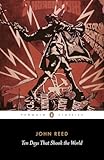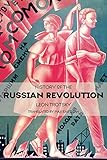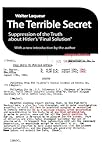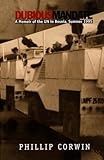I never would have believed it’s possible to have too many books. But a loud noise awakened me one night as a shelf of books crashed to the floor, and I knew it was time to stop collecting and start culling.
That bookcase holds works on European and world history. I emptied the shelves into categories: the bigger piles were about Russia and the Russian Revolution, the Holocaust, German history and WWII, the Middle Ages, Eastern Europe, the Middle East, and ideas. There are the books I’ve read, the books I’ve wanted to read, and the books whose titles intrigued.










 I started reading about Russian Revolution after seeing the movie Reds. My parents and grandparents were all sympathetic to the Communist left, one of my grandfathers even a member of the Party, but I knew nothing about the revolution. At 20 I read Edmund Wilson’s To the Finland Station; I still have that ancient Doubleday Anchor paperback, and keeping it. After seeing Reds I embarked on a reading binge, starting with John Reed’s Ten Days That Shook the World (which the movie was based on), followed by his lover Louise Bryant’s Six Red Months in Russia and Barbara Gelb’s So Short a Time, which was the movie tie-in paperback. Next were The New Russia by Dorothy Thompson (toss), Kronstadt 2021 by Paul Avrich (keep), and Alexander Rabinowitch’s The Bolsheviks Come to Power (I have two copies of this title—one missing a chapter and repeating another, and the replacement copy with an entirely different misprint of missing and repeated chapters). Then there is Victor Serge’s Memoirs of a Revolutionary and Midnight in the Century, along with his novels Conquered City, Birth of Our Power, and The Case of Comrade Tuleyev (which is every bit as good if not better than the much more well-known Darkness at Noon by Arthur Koestler). Serge was the son of Russian revolutionaries in exile in Belgium when the revolution happened; he returned to Russia after an abortive anarchist revolution in Spain in 1914, joined the Bolsheviks, but was critical of Stalin’s power consolidation, and ended up in the early gulag. I’m keeping all of his books.
I started reading about Russian Revolution after seeing the movie Reds. My parents and grandparents were all sympathetic to the Communist left, one of my grandfathers even a member of the Party, but I knew nothing about the revolution. At 20 I read Edmund Wilson’s To the Finland Station; I still have that ancient Doubleday Anchor paperback, and keeping it. After seeing Reds I embarked on a reading binge, starting with John Reed’s Ten Days That Shook the World (which the movie was based on), followed by his lover Louise Bryant’s Six Red Months in Russia and Barbara Gelb’s So Short a Time, which was the movie tie-in paperback. Next were The New Russia by Dorothy Thompson (toss), Kronstadt 2021 by Paul Avrich (keep), and Alexander Rabinowitch’s The Bolsheviks Come to Power (I have two copies of this title—one missing a chapter and repeating another, and the replacement copy with an entirely different misprint of missing and repeated chapters). Then there is Victor Serge’s Memoirs of a Revolutionary and Midnight in the Century, along with his novels Conquered City, Birth of Our Power, and The Case of Comrade Tuleyev (which is every bit as good if not better than the much more well-known Darkness at Noon by Arthur Koestler). Serge was the son of Russian revolutionaries in exile in Belgium when the revolution happened; he returned to Russia after an abortive anarchist revolution in Spain in 1914, joined the Bolsheviks, but was critical of Stalin’s power consolidation, and ended up in the early gulag. I’m keeping all of his books.
 Of course I read Trotsky’s History of the Russian Revolution, which purports to be a first-person account. But Trotsky was in New York City when the revolution broke out in February 1917 and didn’t arrive back in Russia until April. Footnotes and other references in the books I’d been reading often quoted an N.N. Sukhanov, and research pointed me to a one-volume translation of Sukhanov’s 12-volume history of the revolution he lived through. I tracked down the 1940 one-volume English translation (titled The Russian Revolution: 1917 A Personal Record) through interlibrary loan and reading its chatty, vividly detailed pages, realized that perhaps Trotsky had cribbed the early parts of his history from Sukhanov. I wrote a “Save This Book” review for the Village Voice’s Voice Literary Supplement, and Princeton University Press reprinted the book. Of course I’m keeping both Trotsky and Sukhanov, next to each other on the bookshelf.
Of course I read Trotsky’s History of the Russian Revolution, which purports to be a first-person account. But Trotsky was in New York City when the revolution broke out in February 1917 and didn’t arrive back in Russia until April. Footnotes and other references in the books I’d been reading often quoted an N.N. Sukhanov, and research pointed me to a one-volume translation of Sukhanov’s 12-volume history of the revolution he lived through. I tracked down the 1940 one-volume English translation (titled The Russian Revolution: 1917 A Personal Record) through interlibrary loan and reading its chatty, vividly detailed pages, realized that perhaps Trotsky had cribbed the early parts of his history from Sukhanov. I wrote a “Save This Book” review for the Village Voice’s Voice Literary Supplement, and Princeton University Press reprinted the book. Of course I’m keeping both Trotsky and Sukhanov, next to each other on the bookshelf.











 The Holocaust books were another reading binge, this one after reading a galley of Schindler’s Ark when it first came out (the movie changed the title to Schindler’s List). I had only ever thought about the murdered Jews, never about those who survived, and over a year became obsessed with reading as many survivor accounts as I could, as well as histories of the Holocaust. I’m keeping a few that I’ve read (Spiegelman’s Maus II; Lucy Dawidowicz’s The War Against the Jews), along with Jan Gross’s Neighbors (about the Polish town of Jedwabne, where in 1941 half the town’s inhabitants killed the other half) and Anna Bikont’s The Crime and the Silence (about Jedwabne’s massacre of Jews, how it was remembered in Poland, and how Jan Gross’s book was received there—not well). Among the survivor accounts I read and don’t have space to keep are Anus Mundi by Wieslaw Kielar (a non-Jewish prisoner at Auschwitz, which was built originally for Polish prisoners of war); Primo Levi’s The Periodic Table; Charlotte Delbo’s None of Us Will Return; Fania Fenelon’s Playing for Time; The Diary of Anne Frank; Lest Innocent Blood Be Shed by Philip Hallie; Walter Laqueur’s The Terrible Secret: Suppression of the Truth About Hitler’s “Final Solution”; and Stella by Peter Wyden (about a Jewish woman who survived the war in Berlin by turning in other Jews).
The Holocaust books were another reading binge, this one after reading a galley of Schindler’s Ark when it first came out (the movie changed the title to Schindler’s List). I had only ever thought about the murdered Jews, never about those who survived, and over a year became obsessed with reading as many survivor accounts as I could, as well as histories of the Holocaust. I’m keeping a few that I’ve read (Spiegelman’s Maus II; Lucy Dawidowicz’s The War Against the Jews), along with Jan Gross’s Neighbors (about the Polish town of Jedwabne, where in 1941 half the town’s inhabitants killed the other half) and Anna Bikont’s The Crime and the Silence (about Jedwabne’s massacre of Jews, how it was remembered in Poland, and how Jan Gross’s book was received there—not well). Among the survivor accounts I read and don’t have space to keep are Anus Mundi by Wieslaw Kielar (a non-Jewish prisoner at Auschwitz, which was built originally for Polish prisoners of war); Primo Levi’s The Periodic Table; Charlotte Delbo’s None of Us Will Return; Fania Fenelon’s Playing for Time; The Diary of Anne Frank; Lest Innocent Blood Be Shed by Philip Hallie; Walter Laqueur’s The Terrible Secret: Suppression of the Truth About Hitler’s “Final Solution”; and Stella by Peter Wyden (about a Jewish woman who survived the war in Berlin by turning in other Jews).


 Then there are the books about the Third Reich from the German side. I’m keeping Christopher Browning’s Ordinary Men, an attempt to decipher how ordinary men became ordinary murderers; Eichmann in Jerusalem by Hannah Arendt (which I first read as it was serialized in the New Yorker). Two friends who teach German history told me William Sheridan Allen’s The Nazi Seizure of Power: The Experience of a Single German Town, 1930–1935 is a classic they still teach, though I read it for a German history class in 1968; I’m keeping it for whatever lessons it may offer to help prevent our own slide into whatever form of Christian nationalist authoritarianism that U.S. fascism takes.
Then there are the books about the Third Reich from the German side. I’m keeping Christopher Browning’s Ordinary Men, an attempt to decipher how ordinary men became ordinary murderers; Eichmann in Jerusalem by Hannah Arendt (which I first read as it was serialized in the New Yorker). Two friends who teach German history told me William Sheridan Allen’s The Nazi Seizure of Power: The Experience of a Single German Town, 1930–1935 is a classic they still teach, though I read it for a German history class in 1968; I’m keeping it for whatever lessons it may offer to help prevent our own slide into whatever form of Christian nationalist authoritarianism that U.S. fascism takes.




 Why the Middle Ages? As a teen, I read the historical romance Katherine by Anya Seton, about the real-life love affair between Katherine Swinton, commoner and sister-in-law of Geoffrey Chaucer, and John of Gaunt, third son of Edward III. Years later I read Marchette Chute’s biography Geoffrey Chaucer of England to find out how much of that story was real; it’s now an old paperback and can go to the recycle bin. But the history bug had bitten. In college I wrote a paper for a course called the High Middle Ages on Medieval Cities by Henri Pirenne, an influential early 20th-century historian who revised thinking about whether the so-called Dark Ages, after the Roman Empire fell, really were so dark. I had a trio of Pirenne’s books; in addition to Medieval Cities, there was Economic and Social History of Medieval Europe and Mohammed and Charlemagne. All old paperbacks; all to the recycle bin. (If I ever do want to read Mohammed and Charlemagne, it’s in the public library.)
Why the Middle Ages? As a teen, I read the historical romance Katherine by Anya Seton, about the real-life love affair between Katherine Swinton, commoner and sister-in-law of Geoffrey Chaucer, and John of Gaunt, third son of Edward III. Years later I read Marchette Chute’s biography Geoffrey Chaucer of England to find out how much of that story was real; it’s now an old paperback and can go to the recycle bin. But the history bug had bitten. In college I wrote a paper for a course called the High Middle Ages on Medieval Cities by Henri Pirenne, an influential early 20th-century historian who revised thinking about whether the so-called Dark Ages, after the Roman Empire fell, really were so dark. I had a trio of Pirenne’s books; in addition to Medieval Cities, there was Economic and Social History of Medieval Europe and Mohammed and Charlemagne. All old paperbacks; all to the recycle bin. (If I ever do want to read Mohammed and Charlemagne, it’s in the public library.)





 The East European books I started collecting when I was one of the founders of the Network of East-West Women, in 1991, an organization to support women activists in the former Communist countries. Because Yugoslavia fell into civil wars that broke up the country soon after our founding conference was held there, in Dubrovnik, I had quite a few of those: The Fall of Yugoslavia: The Third Balkan War by Misha Glenny; Origins of a Catastrophe: Yugoslavia and Its Destroyers by Warren Zimmerman; Dubious Mandate: A Memoir of the UN in Bosnia, Summer 1995 by Philip Corwin; Secam Se: I Remember: Writings by Bosnian Women Refugees, edited by Radmila Manojlovic Zarkovid. Most of these I gave to a friend who’d written about the war in Bosnia. I’m keeping Katherine Verdery’s What Was Socialism, and What Comes Next (which I’ve read parts of) and Tina Rosenberg’s The Haunted Land (which I haven’t yet); the latter’s subtitle, “Facing Europe’s Ghosts After Communism,” perhaps hints at what underpins the current war between Russia and Ukraine.
The East European books I started collecting when I was one of the founders of the Network of East-West Women, in 1991, an organization to support women activists in the former Communist countries. Because Yugoslavia fell into civil wars that broke up the country soon after our founding conference was held there, in Dubrovnik, I had quite a few of those: The Fall of Yugoslavia: The Third Balkan War by Misha Glenny; Origins of a Catastrophe: Yugoslavia and Its Destroyers by Warren Zimmerman; Dubious Mandate: A Memoir of the UN in Bosnia, Summer 1995 by Philip Corwin; Secam Se: I Remember: Writings by Bosnian Women Refugees, edited by Radmila Manojlovic Zarkovid. Most of these I gave to a friend who’d written about the war in Bosnia. I’m keeping Katherine Verdery’s What Was Socialism, and What Comes Next (which I’ve read parts of) and Tina Rosenberg’s The Haunted Land (which I haven’t yet); the latter’s subtitle, “Facing Europe’s Ghosts After Communism,” perhaps hints at what underpins the current war between Russia and Ukraine.
I am also keeping the 1993 Survival Guide, a project of the Sarajevo arts organization FAMA. Written in 1992–1993, the first year Sarajevo was besieged, Survival Guide takes the form of a surrealist Michelin Guide; as its introduction states, it takes “visitors through the city instructing them how to survive without transportation, hotels, taxis, telephones, food, water, electricity…. It… shows the city of Sarajevo not as a victim, but as a place of experiment where wit can still achieve victory over terror….” The irony imbuing this work perhaps helps to show how people survived communism and can survive any impossible, and seemingly endless, situation.



The Middle East contains Israel, a country I have great ambivalence about. My leftist parents were not Zionists. In my youth, I wanted a dispassionate, objective account of the Middle East, but no such book seemed to exist then. The Israeli historian Benny Morris’s Righteous Victims: A History of the Zionist-Arab Conflict, 1881–2001 was the first book I read that presented both the Israeli and Palestinian sides in ways that made sense to me. Then I read David Shipler’s Arab and Jew, which sympathetically and with nuance breaks down the prejudices Palestinian Arabs had toward Jews, and that Jews had toward Arabs. I’m keeping both Shipler and Morris. Finally, there’s David Fromkin’s A Peace to End All Peace, about the end of the Ottoman Empire and the beginnings of the modern Middle East. I heard Fromkin interviewed some time after September 11; responding to a question about Osama bin Laden, Fromkin said, with some horror in his voice, “It seemed like he had read my book.” I’m keeping this one, too.







 The books not focused on a geographical region or chronological period I put in the “ideas” category. Mark Kurlansky’s Salt I’m keeping; I really want to know how prosaic salt has changed history. A History of the Modern Fact by Mary Poovey? I love the title; I love the idea of its subtitle: “Problems of Knowledge in the Sciences of Wealth and Society.” In an age when stories are replacing reality in politics, what a fact is and how it means are necessary questions. Then there’s The Rise of the West by William H. McNeill. My 1965 New American Library paperback has brittle pages, but I am keeping it; judging from the underlining, I read it thoroughly. It’s the first “history of the world” I read that, despite its title, really included the world outside of Europe and the U.S. On the discard pile, however, are McNeill’s Plagues and Peoples, Hans Zinsser’s Rats, Lice, and History, and C.V. Wedgewood’s The Spoils of Time: A History of the World from Earliest Times to the Sixteenth Century, all too old and falling apart. The Swerve: How the World Became Modern by Stephen Greenblatt I can get from the public library should I have an irresistible urge to read it; Revolution in Time: Clocks and the Making of the Modern World by David S. Landes I sent to a friend, and it’s also available from the library.
The books not focused on a geographical region or chronological period I put in the “ideas” category. Mark Kurlansky’s Salt I’m keeping; I really want to know how prosaic salt has changed history. A History of the Modern Fact by Mary Poovey? I love the title; I love the idea of its subtitle: “Problems of Knowledge in the Sciences of Wealth and Society.” In an age when stories are replacing reality in politics, what a fact is and how it means are necessary questions. Then there’s The Rise of the West by William H. McNeill. My 1965 New American Library paperback has brittle pages, but I am keeping it; judging from the underlining, I read it thoroughly. It’s the first “history of the world” I read that, despite its title, really included the world outside of Europe and the U.S. On the discard pile, however, are McNeill’s Plagues and Peoples, Hans Zinsser’s Rats, Lice, and History, and C.V. Wedgewood’s The Spoils of Time: A History of the World from Earliest Times to the Sixteenth Century, all too old and falling apart. The Swerve: How the World Became Modern by Stephen Greenblatt I can get from the public library should I have an irresistible urge to read it; Revolution in Time: Clocks and the Making of the Modern World by David S. Landes I sent to a friend, and it’s also available from the library.
What’s the state of your private library? Are you running out of space? How would you decide what to keep and what to pass on?
The post A Year in Reading: Sonia Jaffe Robbins appeared first on The Millions.












